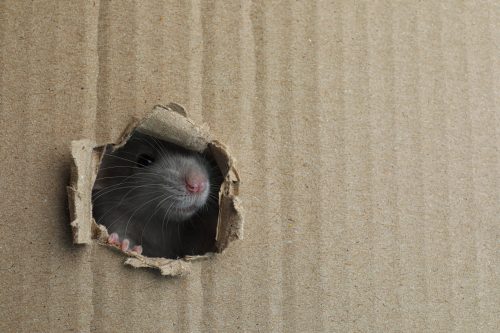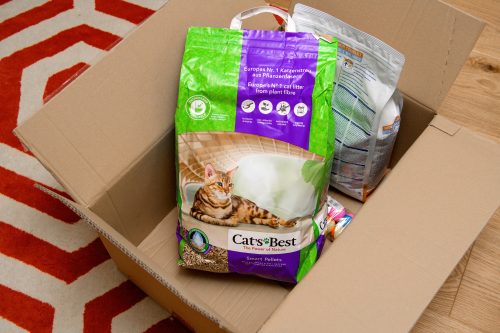What Happens If You Keep Boxes in Your Garage, Exterminators Say

Like basements and attics, garages are one of those spaces in our homes that accumulate things we aren’t using at the moment. Boxes of sports equipment, kids’ clothes, and holiday decorations get stacked on top of each other in corners and are often forgotten. But the garage is a gateway to the great outdoors, and critters like cockroaches, spiders, mice, and even snakes can easily find their way into the same corners to find a dark, undisturbed place to hide. Eventually they can wreak havoc in the garage, and even get into your house. To understand what really happens if you leave boxes in your garage, read on to hear from exterminators.
READ THIS NEXT: 6 Things in Your Garage That Are Bringing Mice to Your Home.
Roaches, spiders, and other bugs love boxes in the garage.

If you keep boxes in your garage, you’re likely to attract a variety of pests, including cockroaches, spiders, and termites.
“Cockroaches love cardboard boxes as they find space to lay eggs and grow their nursery,” says A.H. David, founder of Pest Control Weekly. “Termites and silverfish are other tiny pests that like to hide and eat boxes.”
Rick Conti, pest inspector and owner of Doctor Sniffs, explains that boxes provide a place for these creatures to hide and make nests—even more so if the boxes are filled with materials that can be used as bedding.
“Recently, I had a client whose garage become infested with wood roaches,” Conti shares. “These awful-looking roaches ended up invading his house until he found the source: A cluttered garage with plenty of old boxes.”
Rats and mice seek nesting spots.

In addition to insects and spiders, those boxes could be providing a cozy nesting spot for mice, rats, and other small critters.
According to Charles van Rees, PhD, conservation scientist and founder of the Gulo in Nature blog, from the point of view of the small wildlife living around your garage, keeping extra boxes around, empty or full, is creating what biologists call habitat structure.
“Compared to a big open space, a garage with a bunch of boxes has a lot more room for small animals to navigate,” explains van Rees. “Smaller spaces can stay warmer and cozier and can make protected places for a winter nest. Animals like mice and rats will strip away pieces of cardboard to use for nest linings. It’s as useful to them as it is to us!”
And perhaps an even worse consequence of having rodents in your garage is that snakes may slither in seeking those critters as food. So, what can you do to mitigate the situation? Here are five tips from exterminators.
READ THIS NEXT: 9 Cleaning Habits That Attract Spiders.
1
Make sure your garage is well-sealed.

Natasha Kulinski of Beaver Pest Control says the first step in keeping your garage belongings safe from rodents is to make sure your garage is as well-sealed as possible to prevent their entry.
Using bumper or bristle seals on the bottom of your garage door can keep rats and mice out. “Be sure to check it regularly, though, as rodents will eventually chew their way through if they really want to get inside,” Kulinski warns.
David Price, associate certified entomologist at Mosquito Joe, suggests sealing cracks with silicone caulk, weatherstrips, and rubber seals.
2
Use plastic bins instead of cardboard.

Kulinski strongly suggests using plastic boxes with tight-fitting lids to store items. “Rats and mice will use cardboard, paper, fabric from clothes or linen, and insulation as nesting materials so keeping these in a plastic container can keep those pesky rodents at bay.”
Price says the same tactic will ban bugs, too. “Cardboard boxes can be especially problematic as they are easy for pests to chew through and provide a comfortable place for them to nest.”
For more pest advice delivered straight to your inbox, sign up for our daily newsletter.
3
Keep boxes off the ground.

Kulinkski recommends keeping items off the floor, as rats and mice are attracted to cluttered areas where they can hide undisturbed.
“Keeping your items on shelving units and off the floor will make the space less appealing to rats and mice, and can also help you easily see signs of a rodent infestation in early stages.”
4
Keep food out of the garage.

Price notes that boxes in the garage are especially prone to attracting pests if they contain items that may be appealing to them, such as food, clothing, or paper products.
“Remove food by sweeping up crumbs, tightly sealing garbage bags, and using sealed containers for pet food and birdseed.”
5
Rotate and clean regularly.

One way to keep rodents away is to rotate the items in your garage regularly. “Rats, in particular, are neophobic, which is a fear of something new in their environment,” explains Kulinski. “If you suspect rats have gotten in, rotating your boxes and items around will make your garage less appealing as they will see it as a new environment.”
But, if you’re going to move boxes that have been sitting there for quite a while, “be sure to do so carefully so that you don’t get any surprises,” cautions van Rees.